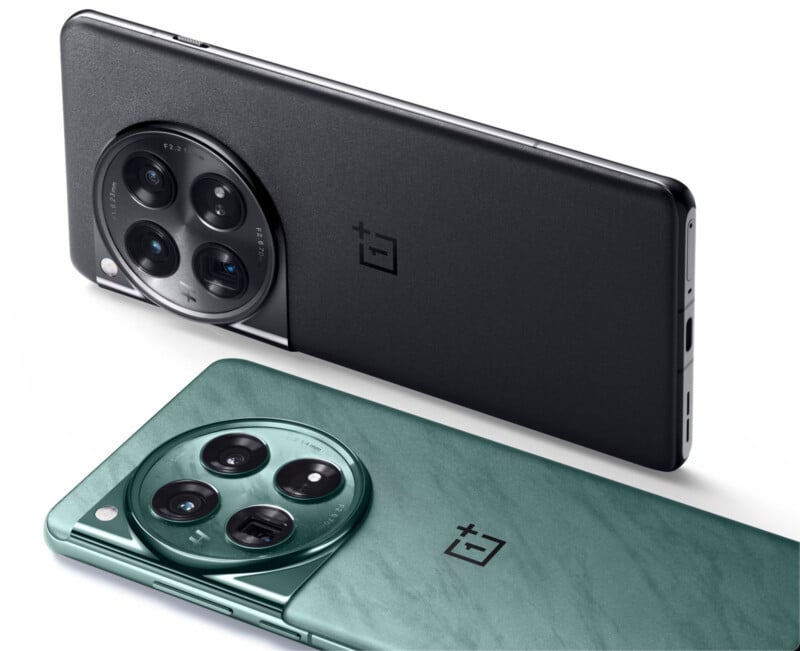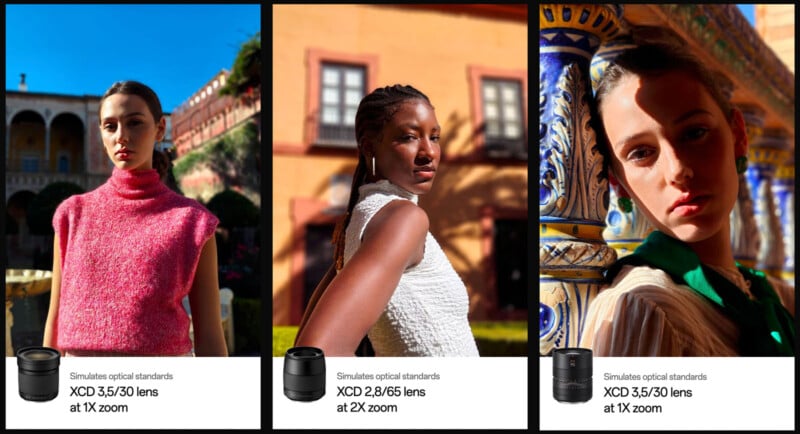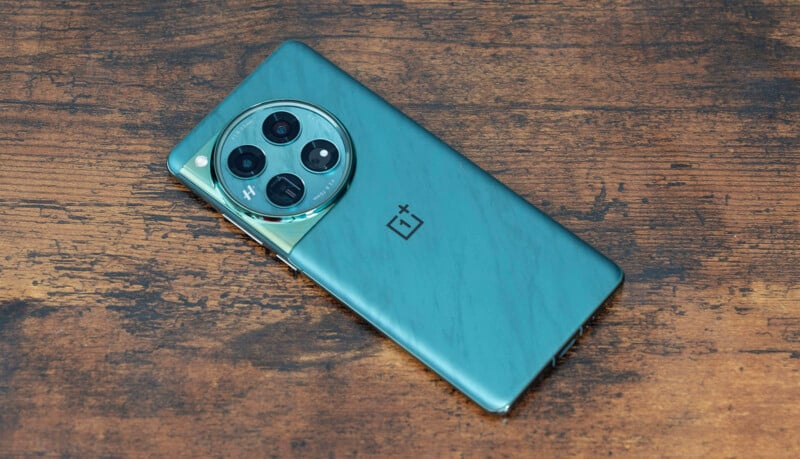![]()
Earlier this week, OnePlus fully revealed its latest flagship smartphone, the OnePlus 12. While PetaPixel continues to work on a full review, which will deliver a deep dive into the phone’s photo features, it is worth taking a closer look at the Hasselblad-branded camera system.
Following in the footsteps of OnePlus’ first foldable phone, the OnePlus Open, the 12 unsurprisingly has some similar hardware under the hood. However, due to the single-slab design of the 12, OnePlus engineers have a bit more space to work within the new device.

The Open marked OnePlus’ first foray into the Sony Lytia LYT-800-series image sensor lineup, sporting the customized LYT-T808 chip for its main camera. The LYT-T808 features a two-layer transistor pixel, also known as pixel-stacked technology, which increases full well capacity (FWC) in a thinner form factor. This improves image quality, especially in low light.
“This revolutionary camera technology dramatically increases the full well capacity of the ‘T’ sensor. FWC is a numerical measurement representing how much light is taken in and stored by the sensor’s photodiodes. [The LYT-808] almost doubles the FWC when compared to sensors without Pixel Stacked Technology,” OnePlus’ North American CEO, Robin Liu, explained to PetaPixel last year.
![]()
As for the OnePlus 12, it doesn’t use the LYT-T808 but instead utilizes the standard LYT-808, which was developed through a collaboration between Sony and OnePlus.
Now, in the Lytia lineup, which Sony Semiconductor brought into 50-megapixel territory in 2023, the LYT-800 family is not the largest smartphone sensor. The LYT-800 sits below the LYT900 series, which measures 16.384 millimeters diagonally (Type 1/0.98). The LYT-800, on the other hand, is a Type 1/1.43 sensor, meaning it is 11.2mm diagonally. Both are stacked, although the LYT-800 is the first Lytia sensor to include a two-layer transistor pixel structure to improve saturation level, otherwise known as full well capacity.
![]()
Interestingly, the OnePlus 12 has reduced FWC compared to the OnePlus Open — 40,000e versus 24,600e. It will be fascinating to see if this reduced FWC impacts the OnePlus 12’s image quality, especially in challenging lighting conditions, where more FWC can aid with dynamic range performance.
In any event, the LYT-808 is still a significant step up from the OnePlus 11’s IMX890 image sensor. OnePlus says the LYT-808 absorbs 50% more light than the IMX890, “ensuring exceptional performance in low-light or backlit environments.” The IMX890 is also a smaller Type 1/1.56 sensor.
![]()
The LYT-808 is paired with a 23mm equivalent f/1.6 lens, a bit different than the 24mm f/1.8 lens in the OnePlus 11.
The OnePlus Open inspired much more than the primary camera in the OnePlus 12. OnePlus has also made significant strides with the two other rear cameras that flank the primary imager.
A notable shortcoming of the OnePlus 11 is its telephoto performance. OnePlus brought a brand-new 3x telephoto camera to its foldable phone, and that same 64-megapixel camera is featured in the OnePlus 12. The OnePlus 11 includes a 32-megapixel IMX709 sensor (Type 1/2.74) with an f/2 lens. The OnePlus 12 takes it up a notch — or two — with a 64MP f/2.6 OIS-equipped 3x zoom lens.
![]()
While the loss of light-gathering, dropping from an f/2 to an f/2.6 aperture, may seem like a downgrade at first glance, the 64MP camera is an OV64B sensor that is 76% larger than the IMX709, more than making up for the loss of lens brightness. Plus, the OnePlus 12’s telephoto is a 3x zoom, and the 11 was a 2x zoom.
This same camera is in the OnePlus Open, which PetaPixel described in its review as “solid and very reliable.” Compared to its predecessor, the 12’s telephoto camera has more zoom, more megapixels, and a bigger sensor.
![]()
The third rear camera, the ultrawide, is unchanged. It includes a 48-megapixel sensor with a 115-degree field of view. It was good before and should still be good now. For selfie fans, the OnePlus 12 has doubled the megapixels (16 to 32MP).
Better hardware is always good, but software is rightfully a key focus for OnePlus. For the past four years, OnePlus has worked closely with Hasselblad on its smartphones, and the relationship pays more and better dividends every year.
“The partnership with Hasselblad began during the development of the OnePlus 9 Series. OnePlus has always prioritized premium user experiences, and strives to significantly improve all aspects of mobile devices. With our top-of-the-line hardware and computational photography, and Hasselblad’s rich aesthetic knowledge and expertise with traditional photography, we partnered to usher in the next big leap forward when it comes to mobile photography,” Liu told PetaPixel last November.
With the OnePlus 12, Hasselblad has brought an upgraded Portrait Mode. Alongside the new 3x telephoto camera, which is often the go-to camera for Portrait Mode, the new phone allows mobile photographers to realistically recreate bokeh and flare effects from famous Hasselblad lenses, including the XCD 30mm, 65mm, and 90V primes. With improved processing power thanks to the Qualcomm Snapdragon 8 Gen 3 processor, OnePlus promises smoother in-focus to out-of-focus transitions and even more natural bokeh effects.

The OnePlus Open’s Portrait Mode is superb, and there’s no reason to expect anything different from the OnePlus 12. The bokeh effects look very natural and in ideal situations, the images look like those captured with a much larger “real” camera.
The OnePlus 12 also builds upon its predecessor’s HDR technology. As OnePlus explains:
The highly acclaimed TurboRAW HDR algorithm from the OnePlus 11 receives significant enhancements for the OnePlus 12. It now can replicate the interplay effects of natural lights and shadows, delivering breathtaking photos. Unlike traditional HDR algorithms that synthesize multiple images captured in underexposed, normally exposed, and overexposed conditions to achieve a perfectly exposed photograph, the Latest HDR Algorithm on the OnePlus 12 comprehends what it sees. Armed with this knowledge, it captures the subtle intricacies of highlights and shadows and processes them according to the laws of the physical world. By recognizing subjects like human faces, it renders them with textured, three-dimensional appearances, resulting in images that evoke a tactile quality.
Real-world experience will put all of OnePlus’ ambitious claims to the test, but based on how everything on the OnePlus Open performs, there’s reason for optimism when it comes to the OnePlus 12. Starting at $800, unlike the $1,700 asking price for the Open, photographers will be able to channel this promising photo technology at a much more palatable price now, too.

Stay tuned for PetaPixel‘s OnePlus 12 review to see if the great photo technology lives up to the hype. It seems a safe bet.
Image credits: OnePlus
